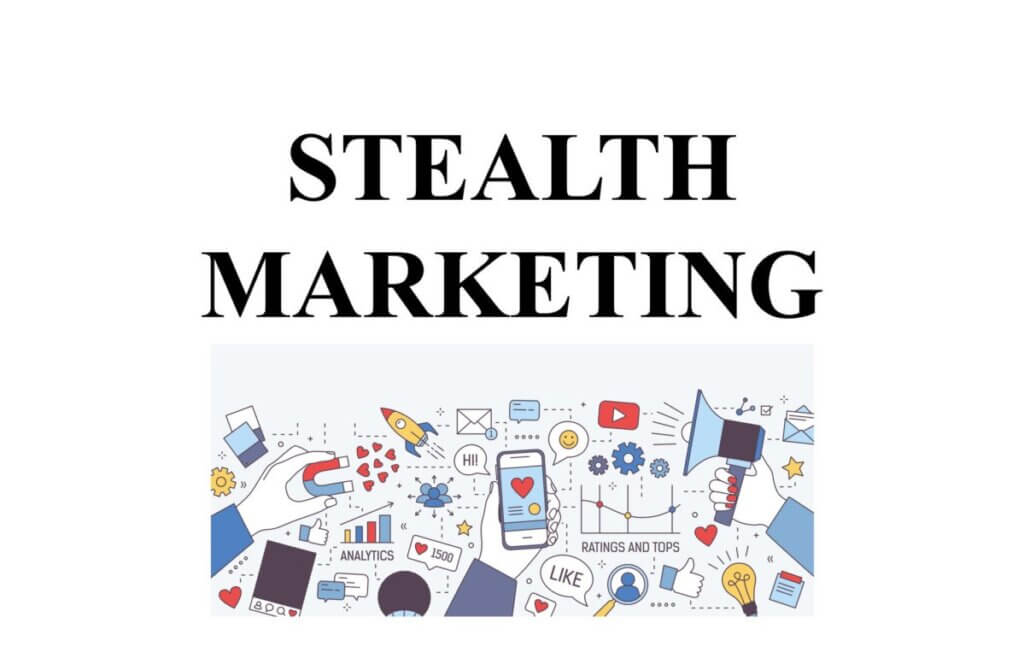Stealth Marketing
Introduction to Stealth Marketing
Stealth marketing, also known as “undercover marketing” or “ambush marketing,” is a type of advertising disguised as an unsolicited endorsement or recommendation. Unlike traditional advertising, which is evident and in-your-face, stealth marketing is designed to blend in with the surrounding environment and go unnoticed. The goal of stealth marketing is to influence consumers by making them believe that they have come to their conclusion about a product or service rather than being sold to.
Definition of Stealth Marketing
Stealth marketing is a form of advertising that uses subtle and non-intrusive techniques to promote a product or service. The aim is to influence consumer behavior without them realizing they are being marketed to. The key to successful stealth marketing is to connect with the consumer naturally and organically, without feeling like they are being sold to.
Importance of Stealth Marketing
Stealth marketing has become increasingly popular as consumers become savvier and less likely to be swayed by traditional advertising. Stealth marketing offers a more subtle and less intrusive way of promoting products or services and can effectively engage consumers.
Purpose of Stealth Marketing
The purpose of stealth marketing is to create a connection with consumers that is more natural and organic than traditional advertising methods. Businesses can build brand awareness, increase credibility, and ultimately drive sales by creating this connection. Additionally, stealth marketing allows companies to target specific demographics, such as age, gender, and interests, more effectively and cost-effectively than other forms of advertising.
In conclusion, stealth marketing is a valuable tool for businesses looking to promote their products or services subtly and effectively. Companies can build brand awareness, increase credibility, and ultimately drive sales by creating a natural and organic connection with consumers.
Types of Stealth Marketing
Stealth marketing is a versatile form of advertising that can be achieved through various techniques. Here are some of the most common types of stealth marketing:
Product Placement
Product placement involves integrating a product or service into a movie, television show, or video game naturally and unobtrusively. This type of stealth marketing allows the product to reach a large audience without feeling like an advertisement. For example, a popular television show may feature a character using a particular smartphone brand, promoting the product to the show’s audience.
Influencer Marketing
Influencer marketing involves partnering with individuals with a large social media following, such as Instagram or YouTube, to promote a product or service. The influencer shares content that showcases the product or service in a way that feels natural and organic to their followers, who are more likely to trust the recommendation.
Guerilla Marketing
Guerilla marketing uses unconventional and unexpected tactics to promote a product or service. This type of stealth marketing often creates a buzz or generates social media interest by doing something unexpected and attention-grabbing. For example, a company may place a hidden camera in a public place to capture people’s reactions to a new product and then share the footage on social media to create interest and excitement.
Undercover Marketing
Undercover marketing involves disguising employees or agents as ordinary consumers to promote a product or service. This type of stealth marketing can take many forms, from posing as customers in a store to creating fake online reviews to generate interest and positive buzz. Undercover marketing aims to make the promotion feel organic and spontaneous rather than an orchestrated marketing campaign.
Viral Marketing
Viral marketing involves creating content designed to be shared and spread quickly and widely through social media and other online channels. The goal of viral marketing is to create a buzz and generate interest in a product or service by getting people to share the content with friends and followers. For example, a company may create a funny video that is designed to.
Advantages of Stealth Marketing
Stealth marketing offers several advantages over traditional advertising methods, including:
Cost-Effective
Stealth marketing can be a cost-effective way to promote a product or service. Companies can reach a large audience without spending much money by relying on word-of-mouth and social media rather than paid advertising. Additionally, because stealth marketing often involves creative and unexpected tactics, it can generate a lot of buzz and interest in a product or service, which can be more effective than traditional advertising methods.
Increased Credibility
Stealth marketing can increase credibility by creating a sense of trust and authenticity. When a product or service is recommended by a friend or someone with a large social media following, consumers are more likely to trust the recommendation and be influenced by it. Additionally, because stealth marketing is often less intrusive and less evident than traditional advertising, consumers are more likely to believe that they have come to their conclusion about a product or service rather than being sold to.
Better Engagement
Stealth marketing is more engaging than traditional advertising because it often involves creative and unexpected tactics. For example, a guerilla marketing campaign that involves a hidden camera and a surprising twist can generate a lot of buzz and interest and get people talking about the product or service.
More Effective Targeting
Stealth marketing can more effectively target specific demographics than traditional advertising methods. For example, influencer marketing allows companies to reach a particular audience, such as women aged 18-35, in a more relevant and less intrusive way than traditional advertising methods. Additionally, stealth marketing often involves creating content designed to be shared and spread quickly and widely through social media and other online channels, which can help companies reach a large and targeted audience.
Improved Brand Awareness
Stealth marketing can improve brand awareness by creating a connection with consumers that is more natural and organic than traditional advertising methods. By using creative and unexpected tactics, companies can create a buzz and generate interest in their products or services, which can help build brand recognition and loyalty over time.
In conclusion, stealth marketing offers several advantages over traditional advertising methods, including cost-effectiveness, increased credibility, better engagement, more effective targeting, and improved brand awareness. By using subtle and non-intrusive techniques, companies can reach a large and targeted audience in a way that feels natural and organic, ultimately driving sales.
Disadvantages of Stealth Marketing
While stealth marketing offers several advantages over traditional advertising methods, it also comes with its own set of challenges and disadvantages, including:
Lack of Control
One of the most significant disadvantages of stealth marketing is its lack of control over the message and delivery. Because stealth marketing relies on word-of-mouth and social media, it can be difficult for companies to control the message and ensure that it is accepted as intended. Additionally, removing or maintaining any negative backlash can be challenging once the news is out there.
Legal Issues
Stealth marketing can sometimes run afoul of advertising laws and regulations, exceptionally when disclosing that a promotion is an advertisement. For example, in some cases, companies may be required to reveal that a social media influencer is being paid to promote a product or service. Failure to do so can result in legal consequences and damage the company’s reputation.
Not Always Effective
While stealth marketing can be effective in certain situations, it may not consistently achieve the desired results. For example, if the marketing campaign is not well-received or does not generate enough buzz, it may not have the desired impact on sales and brand awareness. Additionally, because stealth marketing often relies on creative and unexpected tactics, it can be challenging to measure the results and determine whether the campaign was successful or not.
Ethical Concerns
Stealth marketing can raise ethical concerns, particularly when it comes to the use of deceptive tactics or misleading consumers. For example, creating fake online reviews or disguising employees as customers can be seen as deceptive and unethical and damage a company’s reputation if discovered. Additionally, stealth marketing may be perceived as intrusive or sneaky, leading to negative feelings toward the company and its products or services.
Limited Reach
Stealth marketing may have limited reach compared to traditional advertising methods, mainly if it relies on word-of-mouth or social media. While these methods can effectively reach a targeted audience, they may not get as many people as a large-scale advertising campaign, such as a television commercial or a print ad.
In conclusion, while stealth marketing offers several advantages over traditional advertising methods, it also has disadvantages, including lack of control, legal issues, lack of practicality, ethical concerns, and limited reach. Companies must weigh the potential benefits and drawbacks of stealth marketing before implementing a campaign and must take care to ensure that their movements are legal, ethical, and practical.
How to Implement a Stealth Marketing Campaign
Implementing a successful stealth marketing campaign requires careful planning and execution. Here are some steps to follow when planning and executing a stealth marketing campaign:
- Define Your Target Audience: The first step in any marketing campaign is identifying your target audience. This includes understanding their age, interests, habits, and behaviors. This information will help you tailor your marketing message and approach to best resonate with your target audience.
- Choose the Right Platform: The next step is to choose the right platform for your marketing message. This could be a social media platform, a blog, or a website. Consider the strengths and weaknesses of each platform, and choose the one that best fits your target audience and marketing goals.
- Create Compelling Content: The key to a successful stealth marketing campaign is creating compelling content to engage and captivate your target audience. This can be a blog post, a video, or a social media update. Ensure the content is relevant and interesting to your target audience and provides value to them.
- Choose the Right Influencers: If you’re using influencer marketing as part of your stealth marketing campaign, choosing the right influencers is essential. Look for influencers with a large and engaged following who are a good fit for your brand and target audience. Make sure to work with influencers who are transparent about sponsored content and who have a track record of delivering high-quality content.
- Make It Viral: Once you have created your content and chosen your platform, it’s time to make it go viral. Encourage your target audience to share your content with their friends and followers. This could be through social media, email, or word of mouth. The more people see your content, the more successful your stealth marketing campaign will be.
- Measure Results: Finally, measuring the results of your stealth marketing campaign is essential. This will help you determine what worked and didn’t and enable you to make changes for future campaigns. Use tools like Google Analytics or social media analytics to track the success of your campaign and make data-driven decisions for future marketing efforts.
In conclusion, a successful stealth marketing campaign requires careful planning, execution, and measurement. By identifying your target audience, choosing the right platform, creating compelling content, choosing the right influencers, making it viral, and measuring results, you can implement a stealth marketing campaign to help you reach your marketing goals and grow your business.
Conclusion
Stealth marketing is a type of marketing that uses subtle and indirect methods to promote a product or service. This approach is designed to influence consumer behavior without the consumer realizing that they are being marketed to. While stealth marketing can be an effective way to reach consumers, it also has its advantages and disadvantages.
The advantages of stealth marketing include building trust with consumers, reaching consumers who may be skeptical of traditional marketing methods, and creating a sense of exclusivity and scarcity. However, there are also disadvantages to stealth marketing, including the potential for consumer backlash, the difficulty in measuring the campaign’s effectiveness, and the ethical considerations involved in marketing to consumers in a deceptive manner.
When implementing a stealth marketing campaign, it’s essential to carefully define your target audience, choose the right platform, create compelling content, choose the right influencers, make it viral, and measure results. By following these steps, you can create a successful stealth marketing campaign that helps you reach your marketing goals and grow your business.
In conclusion, stealth marketing can be an effective way to reach consumers. Still, it’s essential to consider the advantages and disadvantages carefully and to implement the campaign ethically and transparently. By taking a strategic and thoughtful approach, you can use stealth marketing to promote your product or service in a way that resonates with your target audience and builds trust.
F.A.Q
What is the meaning of stealth marketing?
Stealth marketing refers to marketing that uses subtle and indirect methods to promote a product or service. The goal of stealth marketing is to influence consumer behavior without the consumer realizing they are being marketed.
Stealth marketing can take many forms, such as product placement, influencer marketing, guerilla marketing, word-of-mouth marketing, and brand integration. The idea behind stealth marketing is to create a sense of authenticity and build trust with consumers by presenting the product or service in a natural and relevant way.
By using stealth marketing techniques, companies can reach consumers who may be skeptical of traditional marketing methods and create a sense of exclusivity and scarcity. However, ethical considerations are also involved in marketing to consumers in a deceptive manner, and it can be challenging to measure the effectiveness of a stealth marketing campaign.
Overall, stealth marketing is a strategic approach to marketing that can be effective when used thoughtfully and ethically.
What are examples of stealth marketing?
Stealth marketing can take many forms, but here are a few examples:
- Product placement: This involves placing a product in a movie, TV show, or other media in a way that is not explicitly promotional. For example, a soda brand appears in a movie or TV show scene.
- Influencer marketing involves partnering with influencers to promote a product or service. Influencers may mention the product in their posts, review it on their blog, or create sponsored content for their followers.
- Guerilla marketing: This unconventional marketing uses surprise and creativity to capture consumers’ attention. For example, a company might place a pop-up store in an unexpected location or create a flash mob to promote a product.
- Word-of-mouth marketing encourages consumers to talk about a product or service to their friends and family. This can be done through referral programs, influencer marketing, or other tactics that encourage consumers to share their experiences with others.
- Brand integration: This involves integrating a brand or product into a movie, TV show, or other media naturally and seamlessly. For example, a brand of sneakers appears in a movie or TV show scene.
These are just a few examples of stealth marketing, but there are many other methods and tactics companies can use to reach consumers in subtle and indirect ways. The goal of stealth marketing is to influence consumer behavior without the consumer realizing they are being marketed.






